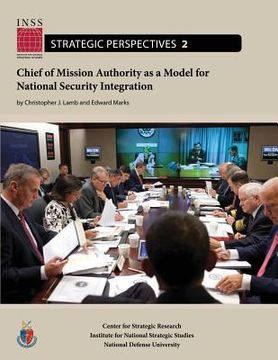Compartir
Chief of Mission Authority as a Model for National Security Integration: Institute for National Strategic Studies, Strategic Perspectives, No. 2 (en Inglés)
National Defense University
(Autor)
·
Christopher J. Lamb
(Autor)
·
Edward Marks
(Autor)
·
Createspace Independent Publishing Platform
· Tapa Blanda
Chief of Mission Authority as a Model for National Security Integration: Institute for National Strategic Studies, Strategic Perspectives, No. 2 (en Inglés) - Marks, Edward ; University, National Defense ; Lamb, Christopher J.
S/ 100,25
S/ 167,09
Ahorras: S/ 66,84
Elige la lista en la que quieres agregar tu producto o crea una nueva lista
✓ Producto agregado correctamente a la lista de deseos.
Ir a Mis Listas
Origen: Estados Unidos
(Costos de importación incluídos en el precio)
Se enviará desde nuestra bodega entre el
Viernes 19 de Julio y el
Martes 30 de Julio.
Lo recibirás en cualquier lugar de Perú entre 2 y 5 días hábiles luego del envío.
Reseña del libro "Chief of Mission Authority as a Model for National Security Integration: Institute for National Strategic Studies, Strategic Perspectives, No. 2 (en Inglés)"
The national security system has an authority problem. The problem is highlighted by the debate over czars, Presidential appointees who oversee a particular issue area, often without Senate confirmation. The practice of appointing czars is controversial for the wrong reasons. Commentators worry that czars create confusion and circumvent congressional oversight. What deserves greater attention is why Presidents appoint czars in the first place and what, if anything, should be done about it. When the interagency process fails to produce the cooperation among departments and agencies necessary to solve a national security (or other) problem, Presidents often designate a lead individual-or czar-to do the job because they do not have enough time to do it themselves. It is widely recognized that the chief executive needs help integrating the diverse departments and agencies, but past attempts to improve interagency cooperation have generally failed because they paid insufficient attention to the difficult problem of authority. New positions or organizations are often created with great fanfare and directed to ensure a coordinated response to some particular national security issue-intelligence, warfighting, reconstruction, or counterterrorism- only to fail because they lack sufficient authority. Ultimately, the departments and agencies in the national security system see little reason to follow their lead. At the heart of the problem is the inability to reconcile a desire for a clear chain of command from the President down through the heads of the departments and agencies with the need to empower new mechanisms (individuals or organizational constructs) with sufficient authority to integrate efforts across the departments and agencies in pursuit of specified national missions. "Unity of command" from the President on down through the functional departments and agencies seems to preclude "unity of effort" for missions that are intrinsically interagency in nature and cut across those same chains of command. In this paper, we argue that solving the interagency integration problem requires an expanded Chief of Mission (COM) authority. COM authority is granted to Ambassadors to oversee and direct the activities of employees from diverse government organizations working in a foreign country, but it could also serve as a model for empowering other leaders in the national security system to solve problems requiring interagency cooperation. As we explain, the Chief of Mission model requires expansion to work well beyond the bilateral setting of a U.S. Embassy in a foreign country, including more legal authority, process adjustments, and wider application. However, the model does point a way forward to escape the dilemma that the current system imposes on Presidents who want unity of effort without sacrificing unified command.

